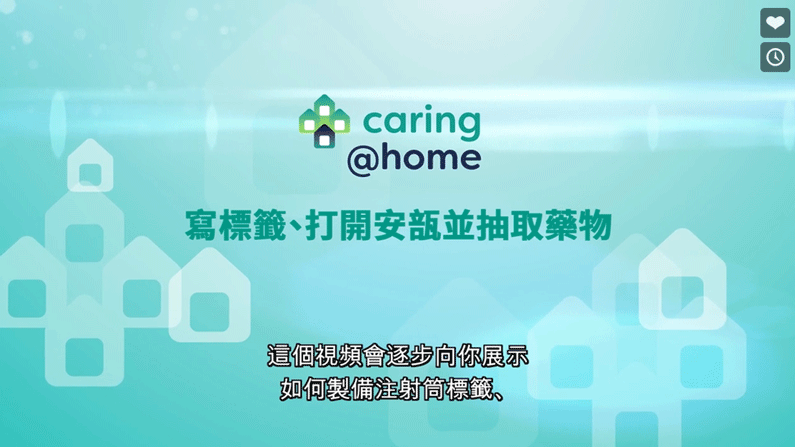Published: 03 December 2024
Transcript
[Music plays]
[Text on screen] caring@home
>>Narrator (female voice over): In this video, you will be shown how to complete a syringe label, open an ampule, and draw up medicine from the ampule by following a step by step process. Your nurse may do all this for you. If this is the case, you may not need to watch this video. Now, choose a surface to work from and wipe it clean. A table is good.
You'll need screw tip syringes, caps to screw onto the tip of the syringes, Blunt drawing up needles, an ampoule of the prescribed medicine, ampoule of sodium chloride 0. 9 percent to draw up the flush syringe, a sharps container, the colour coded sticky labels for the medicine and flush syringes, and a clean container to put your equipment in.
Let's look at how to complete a syringe label. Completing a label is very important. For safety, every syringe with medicine in it must be labelled correctly. Each colour coded sticky label is printed with a medicine name and the symptom that that medicine is used to treat. Completing a label is simple.
You just write the dose of the medicine, The initials of the person who is preparing the syringe and the date of preparation. You also need to initial and date the flush syringe label. You will now be shown how to open an ampoule and draw up medicine. The first thing to do is to wash your hands with soap and water and dry them well.
The next step is to attach the blunt drawing up needle to the syringe. To do this, you will need to remove the syringe and the blunt drawing up needle from their packaging. Take care not to touch the tip of the syringe or the open end of the needle. Keep the needle cover on at this stage. Twist the needle, with its protective cover still on, onto the empty syringe in a clockwise direction.
Next, the ampoule needs to be opened. Some ampoules are glass and others are plastic. The opening technique is different. To open a glass ampoule, you need to hold the ampoule upright and gently flick the top of the ampoule to move any medicine from inside the top to the bottom. If the glass ampoule has a dot on the neck, make sure the dot is facing away from you.
Place your other thumb just above the neck of the ampoule and snap the neck of the ampoule away from you. Opening a plastic ampoule is easier. You simply hold the ampoule in one hand and twist the top of the ampoule with your other hand until it is removed. The next step is to fill the syringe with medicine or, as nurses say, draw up the medicine.
To do this, you need to carefully remove the protective cover from the drawing up needle and insert the needle into the open ampule. Draw the medicine up into the syringe by slowly pulling back on the plunger. Your nurse or doctor will advise you about how much medicine to draw up so that you can get the correct dose in the syringe.
It's very common to get a few air bubbles in the syringe. To remove air bubbles, you need to Withdraw the needle from the ampule and keep it pointed upwards. This position lets you see if there are any air bubbles in the syringe. Gently flick the syringe to get all the bubbles to the top. Push the syringe plunger slowly upwards until most of the air bubbles are removed and until you have the correct volume of medicine left in the syringe.
You may see a small droplet of medicine come out, and that's okay. After drawing up the medicine, you need to remove the blunt drawing up needle and place it into your sharps container. Twist the cap onto the end of the filled syringe. Place the completed colour coded sticky label onto the syringe that you have just filled.
It is best to stick it onto the blank side of the syringe, away from the black volume markings. Dispose of the open ampoule into the sharps container. Finally, you will need to wash and dry your hands again and clean up your work surface. If you are not going to use the medicine in the labelled syringe straight away, store it safely in your refrigerator.
If you have any concerns when you are completing labels, opening ampoules or drawing up medicines, contact your nurse or doctor for advice.
[Text on screen] caring@home
[Music ends]
End of transcript

- Audience General public
- FormatVideo
- Language繁體中文 / Chinese (Traditional)
- Last updated03 December 2024
